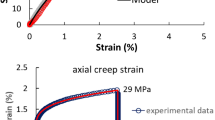Abstract
The present work is mainly stimulated by the definition of the general fractional-order derivative operator (GFODO) involving the Miller–Ross kernel in the sense of the Liouville–Sonine type. The novel emphasis is the introduction of the GFODO within the Miller–Ross kernel into the Maxwell model and Kelvin–Voigt model, thereby constructing viscoelastic constitutive models with the property of inheritance and memorability. It is noteworthy that the fractional viscoelasticity can capture the strain response within a wide range of strain rates. The procedure used in our paper to calculate the creep compliance of the proposed model is the Laplace transform, and then comparisons between the general fractional-order models and the classical integer-order models are presented. In summing up, it may be stated that the general fractional-order Kelvin–Voigt model exhibits a very different behavior compared to the classical Kelvin–Voigt model and it can describe the whole creep process including the accelerated creep stage.







Similar content being viewed by others
References
Wang, P., Liu, E., Zhi, B., et al.: A macro-micro viscoelastic-plastic constitutive model for saturated frozen soil. Mech. Mater. 147, 103411 (2020)
Chen, Y., Yang, P., Zhou, Y., et al.: A micromechanics-based constitutive model for linear viscoelastic particle-reinforced composites. Mech. Mater. 140, 103228 (2020)
Decraemer, W.F., Maes, M.A., Vanhuyse, V.J., et al.: A non-linear viscoelastic constitutive equation for soft biological tissues, based upon a structural model. J. Biomech. 13(7), 559–564 (1980)
Sun, L., Zhu, Y.: A serial two-stage viscoelastic viscoplastic constitutive model with thermodynamical consistency for characterizing time-dependent deformation behavior of asphalt concrete mixtures. Constr. Build. Mater. 40, 584–595 (2013)
Yang, W., et al.: Time-dependent behavior of diabase and a nonlinear creep model. Rock Mech. Rock Eng. 47, 1211–1224 (2014)
Fung, Y.C.: Foundation of Solid Mechanics. Prentice-Hall Inc, Englewood Cliffs, N. J. (1965)
Cunha-Filho, A.G., Briend, Y., et al.: A new and efficient constitutive model based on fractional time derivatives for transient analyses of viscoelastic systems. Mech. Syst. Signal Process. 146, 107042 (2021)
Yajima, T., Nagahama, H.: Differential geometry of viscoelastic models with fractional-order derivatives. J. Phys. A Math. Theor. 43, 385207 (2010)
Somarathna, H.M.C.C., et al.: Hyper-viscoelastic constitutive models for predicting the material behavior of polyurethane under varying strain rates and uniaxial tensile loading. Constr. Build. Mater. 236, 117417 (2020)
Bahraini, S.M.S., et al.: Large deflection of viscoelastic beams using fractional derivative model. J. Mech. Sci. Technol. 27(4), 1063–1070 (2013)
Martin, O.-S., Zhang, J.: Does a fractal microstructure require a fractional viscoelastic model? Fractal Fract. 2, 12 (2018)
Cattani, C.: Fractal and fractional. Fractal Fract. 1, 1 (2017)
Liouville, J.: Memoire sur le calcul des different idles a indices quelconques. Journal de EcolePolytechnique 13(21), 71–162 (1832)
Riemann, B.: Versucheinerallgemeinen auffassung der integration und differentiation. Bernhard Riemanns Gesammelte Mathematische Werke, Janvier, pp. 353–362 (1847)
Caputo, M.: Linear model of dissipation whose q is almost frequency independent-II. Geophys. J. Int. 13, 529–539 (1967)
Caputo, M.: Elasticitàe Dissipazione. Zanichelli, Bologna (1969)
Weyl, H.: Bemerkungen zum Begriff des Differentialquotienten gebrochener Ordnung. Zür. Naturf. Ges. 62, 296–302 (1917)
Hilfer, R.: Applications of Fractional Calculus in Physics. World Scientific Publishing, New York (2000)
Fernandez, A., Ozarslan, M.A., Baleanu, D.: On fractional calculus with general analytic kernels. Appl. Math. Comput. 354, 248–265 (2019)
Baleanu, D., Fernandez, A., Akgul, A.: On a fractional operator combining proportional and classical differintegrals. Mathematics 8, 360 (2020)
Cattani, C.: A review on harmonic wavelets and their fractional extension. J. Adv. Eng. Comput. 2(4), 224–238 (2018)
Fernandez, A., Baleanu, D., Srivastava, H.M.: Series representations for fractional-calculus operators involving generalised Mittag–Leffler functions. Commun. Nonlinear Sci. Numer. Simul. 67, 517–527 (2019)
Dou, L., Yang, X.J., Liu, J.: A new general fractional-order wave model involving Miller–Ross kernel. Thermal ence 23(S3), S245–S245 (2019)
Feng, Y.Y., Liu, J.G.: Anomalous diffusion equation using a new general fractional derivative within the Miller–Ross kernel. Mod. Phys. Lett. B 34, 27 (2020)
Yang, X.J., Gao, F., Ju, Y.: General Fractional Derivatives With Applications in Viscoelasticity. Academic Press, London (2020)
Miller, K.S., Ross, B.: An Introduction to the Fractional Calculus and Fractional Differential Equations. Wiley, New York (1993)
Yang, X.J.: General Fractional Derivatives: Theory, Methods and Applications. CRC Press, New York (2019)
Doetch, G.: Theorie und Anwendung der Laplace-Transformation. Springer, Berlin (1937)
Morro, A.: Modelling of viscoelastic materials and creep behaviour. Meccanica 52, 3015–3021 (2017)
Blair, G.S.: The role of psychophysics in rheology. J. Colloid Sci. 2(1), 21–32 (1947)
Heaviside, O.: Electrical Papers, Elibron Classics, London, 1892, v. 1
Prabhakar, T.R.: A singular integral equation with a generalized Mittag–Leffler function in the kernel. Yokohama Math. J. 19(1), 7–15 (1971)
Acknowledgements
This work was supported by the Yue-Qi Scholar of the China University of Mining and Technology (Grant No. 102504180004).
Author information
Authors and Affiliations
Corresponding author
Additional information
Publisher's Note
Springer Nature remains neutral with regard to jurisdictional claims in published maps and institutional affiliations.
Rights and permissions
About this article
Cite this article
Feng, YY., Yang, XJ., Liu, JG. et al. Rheological analysis of the general fractional-order viscoelastic model involving the Miller–Ross kernel. Acta Mech 232, 3141–3148 (2021). https://doi.org/10.1007/s00707-021-02994-7
Received:
Revised:
Accepted:
Published:
Issue Date:
DOI: https://doi.org/10.1007/s00707-021-02994-7




